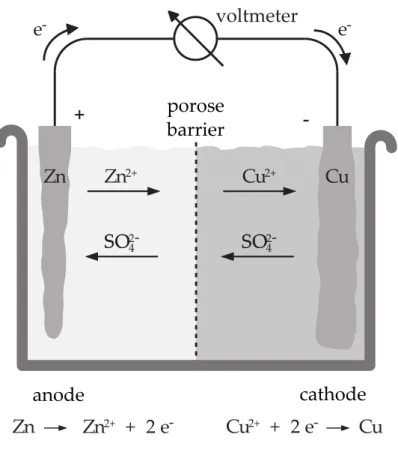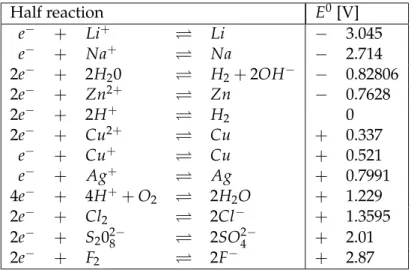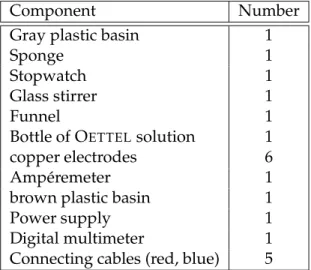IIE3
Modul Electricity II
Faraday-Constant
The purpose of this experiment is to determine the F
ARADAYconstant
with the help of a Coulomb meter. The Coulomb meter consists of three
copper electrodes which are immersed in a copper sulfate solution. After
an electric current was allowed to flow through the Coulomb meter for
about an hour, the amount of copper transported during this time has to
be determined by weighing it. From this, the F
ARADAYconstant can be
calculated.
The purpose of this experiment is to determine the FARADAYconstant with the help of a Coulomb meter. The Coulomb meter consists of three copper electrodes which are immersed in a cop- per sulfate solution. After an electric current was allowed to flow through the Coulomb meter for about an hour, the amount of copper transported during this time has to be determined by weighing it. From this, the FARADAYconstant can be calculated.
c
AP, Department of Physics, University of Basel, February 2017
1.1 Preparatory questions
• What are ions, salts, bases and acids?
• Explain the terms electrolysis, electrolyte.
• What is Faraday’s law?
• What is an electrochemical potential, what is a standard potential and what is a reduc- tion potential?
• What are metals and how are they differentiated from metalloids? When is a metal a noble metal?
• Our experimental set-up enables the following half reactions among others:
at the anode (oxidation):
2SO
24+→ S
2O
2−8
+ 2e
−2H
2O → O
2+ 4H
++ 4e
−Cu → Cu
2++ 2e
−at the cathode (reduction):
2e
−+ 2H
2O → H
2+ 2OH
−2e
−+ 2H
+→ H
22e
−+ Cu
2+→ Cu Why does only the final one happen in both cases?
• Would it be possible to build a Coulomb meter made of zinc and zinc electrodes instead of copper and copper electrodes?
1.2 Theory
1.2.1 Electrolysis
In liquids or gasses, unlike in solids, atoms or molecules are not at fixed positions. Therefore, the current can also be transported via charged atoms or molecules, whereas in solids, this transport usually happens via free (free moving) electrons
1. Charged atoms or molecules are called ions. We distinguish
• cations, positively charged ions, e.g. H
+, Zn
2+or Cu
2+• anions, negatively charged ions, e.g. OH
−, SO
24−or Cl
−The anions have one or more electrons too many to be electrically neutral; the cations have one or more electrons too few. One way ions occur is by dissolving salts
2, for example:
NaCl ⇋ Na
++ Cl
−(1.1)
CuSO
4⇋ Cu
2++ SO
24−(1.2)
1One category for solids with free electrons are metals. These kinds of substances are called first class conduc- tors.
2A salt is typically a metal non-metal compound, where the bond is strongly polar (ionic; the non-metal snatches one or more electrons from the metal).
3
When dissolving an acid in water, ions are also produced. One or more H
+ions (which are de facto protons) are split off
3, for example:
HCl ⇋ Cl
−+ H
+(1.3)
H
2SO
4⇋ HSO
−4
+ H
+(1.4)
HSO
4−⇋ SO
24
− + H
+(1.5)
This process is called dissociation. Quite similarly, dissolving a base leads to the formation of an OH
−ion, for example:
NaOH ⇋ Na
++ OH
−(1.6)
When dissociating water both an H
+ion as well as an OH
−ion are formed:
H
2O ⇋ OH
−+ H
+(1.7)
To sum up, ions are formed either by dissolving salts as well as by dissociation of acids and bases in water.
An electrolyte is what we call a fluid which conducts electrical currents. This conductivity is due to ions. As examples for electrolytes we can mention molten salts as well as water which contains solutions of salts, acids or bases. Pure water is a poor electrical conductor.
While it produces ions continuously (reaction (1.7)), they keep recombining to H
2O molecules (counter reaction), such that there are only a small amount of ions in the equilibrium state (c ( H
+) · c ( OH
−) = 1 · 10
−14). Only by adding a salt or a strongly dissociating acid or base enough ions are formed to reach a good conductivity.
If an electric current is applied to an electrolyte, the ions diffuse to the electrodes due to electric attraction: the anions go to the anode (positive charge) where they leave behind one or more electrons, i.e. they are oxidized; the cations go to the cathode (negative charge) where they pick up one or more electrons, i.e. the cations are reduced. Thus, the electric circuit is closed.
When seen from outside, electrons flow in from the anode and flow out through the cathode.
The kind of chemical reaction caused by an electric charge is called electrolysis. As the case may be, the products of this reaction may either adhere to the electrode (e.g. when producing a silver coating through galvanization), or settle as slag, or stay dissolved or be set free as gases.
In our experiment, the O
ETTELsolution (copper sulfate with added sulfuric acid and alcohol) serves as electrolyte. The electrodes consist of copper. Copper is co-deposited at the cathode.
New copper ions enter the solution from the anode. Therefore, the cathode becomes heavier while the anode becomes lighter. This process is illustrated in figure 1.1.
1.2.2 F
ARADAY’s law
According to F
ARADAY’s law, the mass transported in an electrolyte is proportional to the transported charge:
m = M z · F
· Q (1.8)
The F
ARADAYconstant is the product of the two natural constants elementary charge e[As]
and A
VOGADRO’ constant N
A[
mol1] :
F = e · N
A= 9.6485209 · 10
4As
mol (1.9)
3Due to the high electronegativity of oxygen atoms, the oxygen in water molecules is partially negatively charged. This negatively charged pole is able to snatch the proton from the acids.
4
SO
2-Cu Cu
SO
4SO SO
24-Cu
2+Cu
2+electrodes
electrolyte
anode cathode
Cu Cu
2++ 2 e
-Cu
2++ 2 e
-Cu voltage source
Figure 1.1: Electrolysis of copper sulfate m [ g ] Transported mass
M [
molg] Molar mass
Q [ As ] Transported charge
z Number of charges per molecule F [
molAs] F
ARADAYconstant
1.2.3 Redox reactions, electrochemical potentials
A redox reaction is what we call the combination of reduction and oxidation. Reduction means taking on electrons, oxidation means dispensing electrons. There are always two sub- stances involved in a redox process: one substance is oxidized, giving away one or more electrons to a second substance which is thereby reduced. For example, in the reaction
Zn + 2H
+⇋ Zn
2++ H
2(1.10)
metallic zinc is oxidized while hydrogen ions are reduced to hydrogen gas. This reaction happens when a zinc sheet is put into a diluted
4acid. By contrast, copper is not affected by acids. The reaction
Cu + 2H
+⇋ Cu
2++ H
2(1.11)
does not occur. Evidently, copper is not as easily oxidized as zinc. This is due to the different electrochemical potentials of the two reactions. If a zinc electrode is submerged in a zinc sulfate solution and a copper electrode is submerged in a copper sulfate solution, connecting the two electrodes with a wire causes the copper ions to be reduced and be co-deposited at the copper electrode while the zinc electrode is oxidized and the zinc ions are dissolved. The electrons transferred in this process flow through the wire from the zinc anode to the copper cathode. The sulfations (SO
24−) do not take part in the reaction. If the copper sulfate and the
4dissolved in water
5
voltmeter
Zn Zn
2++ 2 e
-Cu
2++ 2 e
-Cu Cu Zn Zn
2+SO
2-SO
4SO SO
24-Cu
2+e
-e
-porose barrier
anode cathode
Figure 1.2: Set-up of the Daniell element
zinc sulfate are spatially separated from each other, the copper sulfate solution is negatively charged by removing Cu
2+ions, whereas the zinc sulfate solution is positively charged by adding Zn
2+ions: an electrical potential is created and grows until there is no more current flowing, which prevents further redox reactions from occurring. In order to keep the redox reaction going, the two solutions need to be connected in such a way that ion exchange is possible, but mixing
5is not possible. One way to achieve this is by using a porous divider.
Such a set-up is called Daniell element. Thus, a stable potential difference is created between anode and cathode. It can be measured with a voltmeter. The measured voltage corresponds to the difference of the electrochemical potentials of copper and zinc. The electrochemical potential of a substance cannot be measured absolutely, since for the measurement a second half cell with likewise unknown potential is necessary. However, the relative potential to a reference electrode can be measured.
The Standard hydrogen electrode serves as reference electrode. It consists of hydrogen gas which flows around a platinum electrode at a pressure of 101, 3 kPa. The electrode is sub- merged in an acid solution with an H
+concentration of c ( H
+) = 1 mol/l. The electrochemi- cal potential between a half cell of a given substance X and the Standard hydrogen electrode is called its standard potential. The half cell for the standard potential consists of an elec- trode (reduced form of X) and a corresponding ion solution of concentration c ( X ) = 1mol/l (oxidized form of X). Apart from the concentration (or rather: from the activity), the elec- trochemical potential is temperature dependent. Table 1.1 lists several standard potentials at 25
◦C
◦. The given voltages refer to the reduction process (left to right), which is why they are also known as reduction potentials.
5ifCu2+ions were to reach the zinc anode, they would oxidize the zinc directly, precluding the flow of electrons from the anode to the cathode.
6
Half reaction E
0[V]
e
−+ Li
+⇋ Li − 3.045
e
−+ Na
+⇋ Na − 2.714
2e
−+ 2H
20 ⇋ H
2+ 2OH
−− 0.82806
2e
−+ Zn
2+⇋ Zn − 0.7628
2e
−+ 2H
+⇋ H
20
2e
−+ Cu
2+⇋ Cu + 0.337
e
−+ Cu
+⇋ Cu + 0.521
e
−+ Ag
+⇋ Ag + 0.7991
4e
−+ 4H
++ O
2⇋ 2H
2O + 1.229
2e
−+ Cl
2⇋ 2Cl
−+ 1.3595
2e
−+ S
20
28−⇋ 2SO
2−4
+ 2.01
2e
−+ F
2⇋ 2F
−+ 2.87
Table 1.1: some standard potentials
In the event that the reduction equation is supposed to be formulated as a combination of oxidation and reduction, the oxidation has to be written in opposite order (right to left). The corresponding standard potential is taken into account with opposite sign ( − E
0). By adding the equations and the standard potentials, we get the total equation and the resulting electro- chemical potential. Suppose we measure a voltage of 1.10V at the Daniell experiment:
Cathode: 2e
−+ Cu
2+→ Cu ( s ) E
0= + 0.34V Anode: Zn ( s ) → Zn
2++ 2e
−− E
0= + 0.76V Complete reaction: Zn ( s ) + Cu
2+⇋ Cu ( s ) + Zn
2+∆ E
0= + 1.10V
Among all the possible reactions, only the one with the biggest ∆ E
0actually happens. If a substance is further down in the table 1.1, it is more easily reduced and thus a stronger oxidizing agent.
Reactions with ∆ E
0< 0 occur in opposite direction. Thus, we can easily verify that reaction (1.10) does happen while reaction (1.11) does not. Therefore, all metals with positive standard potential are not dissolved in acid. That is why they are called noble metals.
In our experiment, both half cells are made of a copper anode (cathode) in copper sulfate solution, which means they are identical. The "Total reaction"
Cu
2++ Cu ( s ) ⇋ Cu ( s ) + Cu
2+(1.12) does not occur spontaneously, since ∆ E
0= 0. The electrolysis is induced by applying an electrical current.
1.3 Experiment
The Coulomb meter consists of three copper electrodes, where the middle one is meant to be the cathode. A copper sulfate solution (O
ETTELsolution) is used as electrolyte.
7
1.3.1 Equipment
Component Number
Gray plastic basin 1
Sponge 1
Stopwatch 1
Glass stirrer 1
Funnel 1
Bottle of O
ETTELsolution 1
copper electrodes 6
Ampéremeter 1
brown plastic basin 1
Power supply 1
Digital multimeter 1
Connecting cables (red, blue) 5
Composition of the O
ETTELsolution
Ingredient Amount
Water 10 dl
Copper sulfate 125 g Sulfuric acid 50 g
Alcohol 50 g
1.3.2 Experimental set-up
• Place the copper electrodes into the gray plastic basin and connect the cables according to figure 1.3.
voltage source amperemeter coulomb meter
![Figure 1.1: Electrolysis of copper sulfate m [ g ] Transported mass](https://thumb-eu.123doks.com/thumbv2/1library_info/3953279.1534832/6.892.246.645.96.527/figure-electrolysis-copper-sulfate-m-g-transported-mass.webp)


